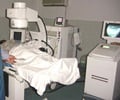Researchers at Johns Hopkins have discovered a window in kidney growth that affects the onset of polycystic kidney disease and can mean, in mice, the difference between developing severe cystic disease early in adolescence or late in adulthood.
In the December issue of Nature Medicine, the team reports that genetic mutations acquired before this window result in immediate disease onset whereas those acquired after don’t give rise to disease until late adulthood.“The question we want to answer is when do these cysts form?” says Gregory Germino, M.D., a professor of nephrology and member of the McKusick-Nathans Institute of Genetic Medicine at Hopkins. “If the cysts form slowly throughout life, that’s one issue, but if they all form while you’re young, then in theory it might be possible to go in there and knock out their growth and the disease will be gone.”
Polycystic kidney disease refers to a group of disorders that cause multiple cysts to grow throughout the kidneys. The most common form is caused by a faulty version of the gene Pkd1. Most people affected develop the condition in late adulthood.
To pinpoint exactly when cysts start forming, the research team knocked out the Pkd1 gene in mice at different times. Knocking out Pkd1 two days after birth caused grossly enlarged kidneys to develop within two weeks.
“Since that didn’t mimic the human condition at all, we then started knocking out Pkd1 in older mice,” says Klaus Piontek, Ph.D., a nephrology research associate at Hopkins.
Knocking out Pkd1 in 6-week-old mice, an early adult age for mice, resulted in no cysts for six months, which is the mouse-equivalent of middle age in humans. The team then knocked out Pkd1 in younger and younger mice and found that mice younger than 12 days developed severe cysts within three weeks. Mice older than 14 days, however, did not develop cystic kidneys for six months.
Advertisement
“This two day window actually raises more questions, like what is this gene doing in adulthood and how is it that cysts are so slow to form?” says Piontek.
Advertisement
“It’s like studying the big bang—you need to be able to see what happened in that first second after the big bang to know what happened,” says Germino. “We now have a good model for doing that with kidney cysts.”
The research was funded by the National Institutes of Health and the U.S. National Kidney Foundation.
Source-John Hopkins
LIN/S











